Contents
- What does technical grape variety mean?
- What is the difference between technical grapes and table grapes
- Technical varieties of white grapes
- Technical varieties of red (pink) grapes
- Varieties of technical black grapes
- Early technical grape varieties
- Technical frost-resistant grape varieties
- New technical grape varieties
- Conclusion
Technical grape varieties are less in demand than table grapes. However, they are represented by numerous varieties that deserve detailed consideration.
What does technical grape variety mean?
Technical varieties are called varieties intended for processing. The fruits are rarely consumed fresh, but raisins, compotes, juices, wines, vinegars and marinades are prepared from them.
The main feature of technical varieties is the content of juice in berries at the level of 75-85% and looseness of the brushes. Grapes can be both sugary and slightly sour – in the first case it is used to create juices and compotes, in the second it is often used to make wine or cognac.
What is the difference between technical grapes and table grapes
The difference between table grapes and technical grapes lies primarily in the appearance and structure of the berries. Dessert varieties are characterized by:
- large fruits;
- large or medium-sized clusters;
- dense and crispy pulp;
- external attractiveness of the fruit;
- low bone content.
Technical grapes intended for processing, most often have small fruits and tassels. There are a lot of seeds in such berries. The pulp is usually soft, without crunchiness, but with increased juiciness.
Technical varieties of white grapes
Technical light grapes are used to make white wines, juice and yellow raisins. Several varieties are especially popular.
Aligote (Aligote)
Western European technical variety of folk selection ripens in the second half of September. Produces medium-sized clusters with tightly fitting yellowish-green berries. The fruits are juicy and delicate in taste, with a firm skin, sometimes covered with brownish sun spots.
Aligote is distinguished by good quality berries and a stable high yield. The disadvantage is low frost resistance and the tendency of ripe fruits to shed.
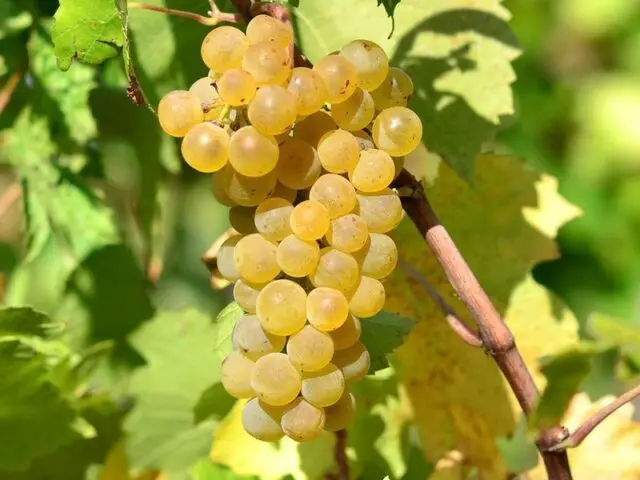
Aligote requires regular preventive treatments against fungi and pests
Crystal
The shrub gives yellow-green fruits, collected in cylindrical-conical loose clusters, ripens by mid-August. It has a harmonious taste and high juiciness, demonstrates frost resistance and good immunity to pests and fungi.
The disadvantages of the Crystal variety include shedding of the ovary in the absence of formation. In addition, excessive accumulation of sugar in fruits reduces the level of acidity – the grapes become less suitable for making wine. Therefore, the plant must be carefully looked after and harvested immediately after it ripens.
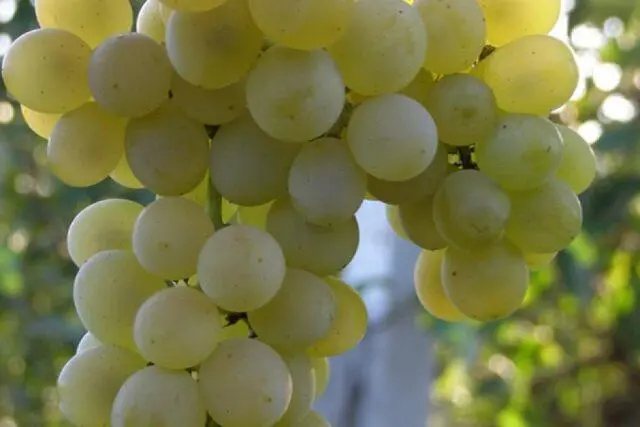
Annual shoots of technical grapes Crystal demonstrate ripening up to 100%
Muscat Odessa
In the list of technical varieties of grapes, it is necessary to mention a hybrid with conical or cylindrical racemes. The shrub produces rounded greenish or yellowish berries with sweet, slimy flesh. Ripens mid-September. It does not suffer from frost, but the variety needs to be grown in the south. In temperate climates, the harvest will not have time to fully ripen before the onset of autumn.
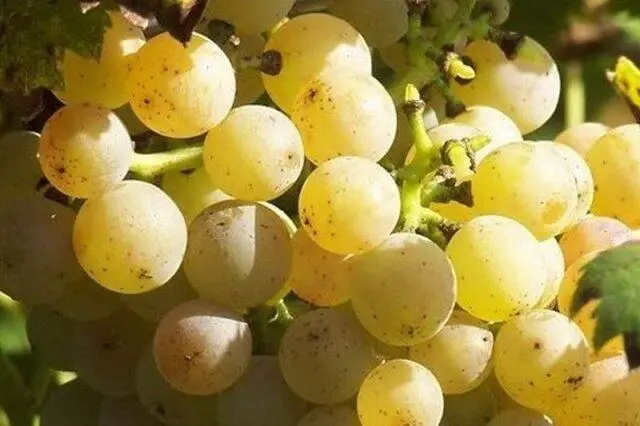
Muscat Odessa often suffers from pests and fungi and does not tolerate waterlogged soils
Platovsky
The shrub bears fruit with rounded small white berries that turn pink in the sun. It is distinguished by good ripening of the vine and immunity to major ailments, calmly tolerates cold snaps. It has high juiciness, the taste is harmonious and sweet, almost without sourness.
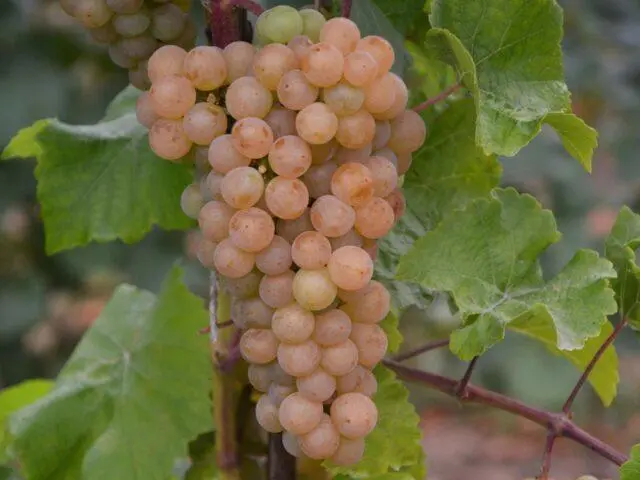
Platovsky grape berries do not crumble after ripening up to 30 days
Chardonnay
The well-known technical grade gives friable brushes with the light green berries covered with a wax raid. The fruits are round, slightly elongated, with a few brownish spots on the skin. Unlike many other varieties, Chardonnay thrives well in cool climates.
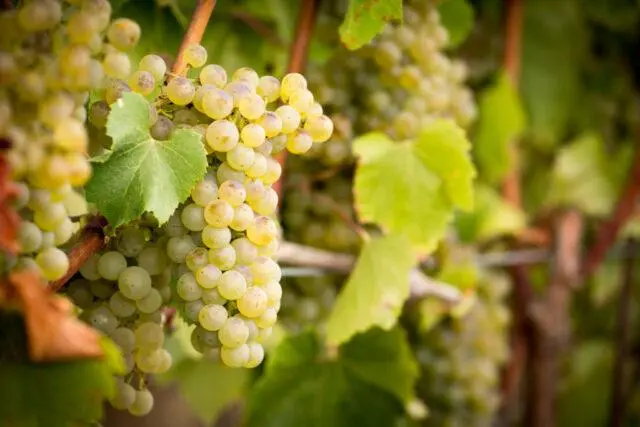
Chardonnay is prone to cracking and needs to be harvested on time.
Technical varieties of red (pink) grapes
Technical pink grapes are used to make red wines, juices and other drinks. Among the popular varieties there are many muscats, which have a particularly rich taste and aroma.
Diana (Diana)
American red grapes with good ripening rates produce dark pink rounded berries of small size. The flesh is slimy and slightly sour, crispy, with a medium firm skin. The technical grade ripens in September, has good keeping quality and is suitable for long transportation.
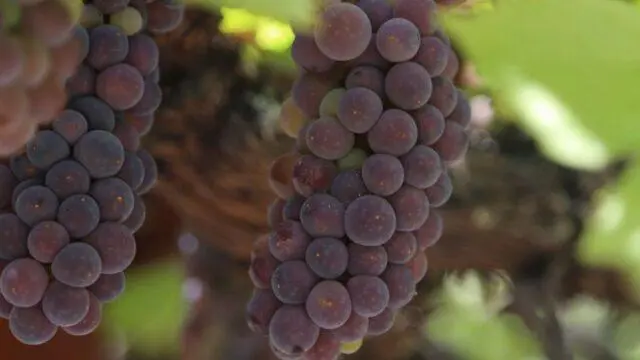
Diana grapes withstand winter frosts down to -30 ° C
Lydia
In the review of technical grape varieties, Lydia deserves mention – a species with dark red berries with a lilac wax coating. It has an unusual strawberry flavor and aroma. Brings branched and loose conical brushes at the end of September, is highly resistant to waterlogged soil and major fungal diseases. The disadvantages of the variety include the need for constant pinching – the shrub overgrows very quickly. It is recommended to harvest the crop immediately after the berries reach ripeness, since they do not last long on the shoots.
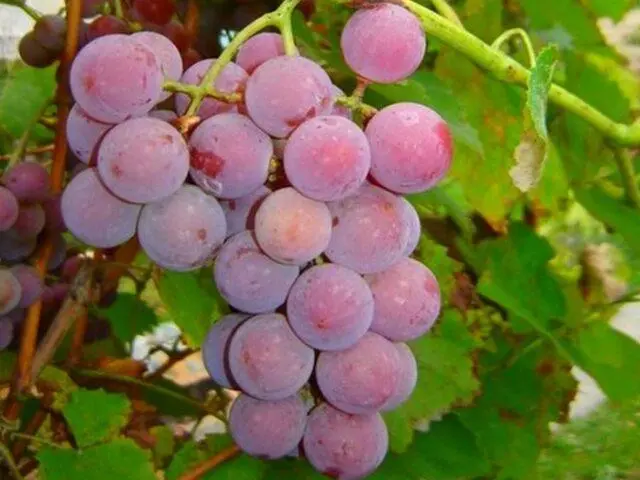
Technical grape variety Lydia suitable for cultivation in northern regions
Gurzuf pink
Vigorous technical grapes with cylindrical or conical racemes have a pronounced nutmeg aroma. Berries brings small, rounded shape, with dark red dense skin. Ripens early in early August, suitable for areas with short and little sunshine.
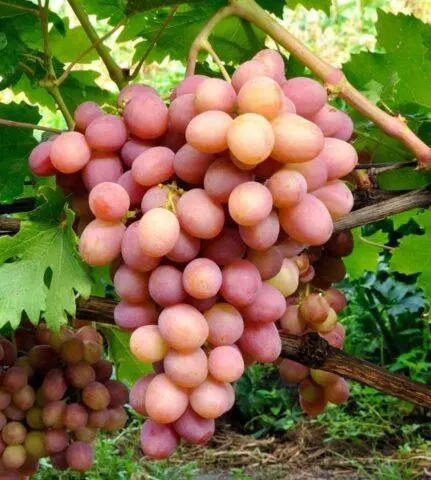
Gurzuf pink often suffers from wasps and other insects
pink muscat
The photo and description of the technical grape variety report that Pink Muscat bears fruit with dark red rounded berries that darken as they ripen. Characterized by high juiciness and tart taste and aroma, it reaches ripeness in early September.
Pink Muscat has a stable yield and tolerates drought. The disadvantages include exactingness to the quality of the soil and low frost resistance.
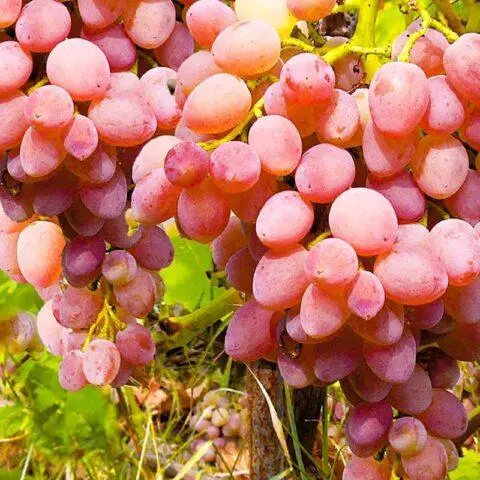
Pink Muscat belongs to varieties with high sugar content and is used in the manufacture of sweet wines and liqueurs.
Donkey’s gift
Technical wine grape variety Gift of Magarach with medium-sized clusters produces light pink berries with a white waxy coating. The peel of the fruit is thin and elastic, the pulp is mucous in structure, with a pleasant taste and no specific smell. The crop can be harvested from the shoots at the end of August.
The gift of Magarach bears fruit abundantly and regularly, rarely affected by fungi. It does not suffer from frost, but in clay soil against the background of waterlogging it can rot.

The technical grade Gift of Magarach requires rationing of the ovary, since the brushes often overload the vine
Varieties of technical black grapes
Black technical grapes are characterized by increased sweetness. Varieties are used in the creation of red wines and strong alcoholic beverages, and are also dried to obtain healthy and tasty raisins.
Isabella
One of the oldest dark varieties of technical grapes is widely distributed throughout the world. The bushes are vigorous, with cylindrical brushes of medium looseness, consisting of rounded black berries. The skin is dense and thick, the flesh is dark red, with a strawberry smell. It ripens late by the beginning of October, so the variety is grown in the south.
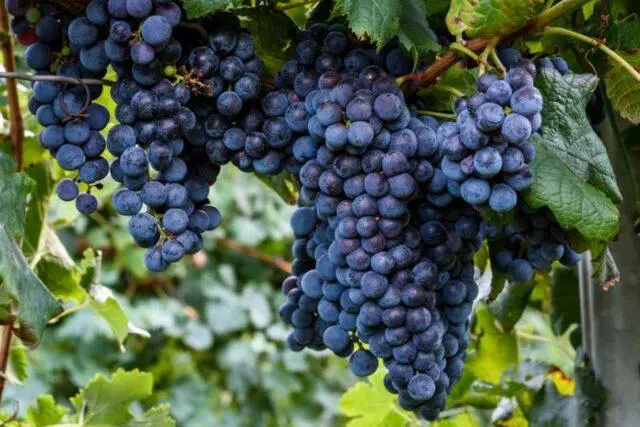
Isabella tolerates high humidity well, but is sensitive to drought.
Augustus
The southern variety with dark blue small fruits has a nutmeg flavor and a light pleasant aroma. Valued for high immunity and frost resistance down to -25 ° C, it ripens in medium terms. Requires quality care, because it reacts poorly to excess or lack of moisture. Often produces side shoots that overload the bush and need pruning.
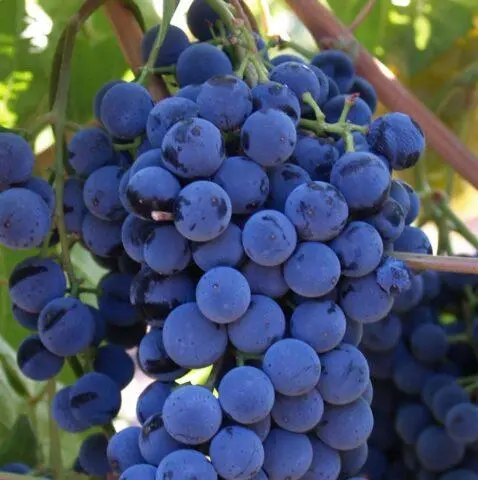
You can harvest Augusta grapes in late August or early September
Alpha
The vigorous variety has high cold resistance and is suitable for breeding in the northern regions and Primorye. Used to create drinks and for landscaping, it bears red-brown or purple berries, collected in cylindrical brushes. The taste is sour, so the variety is used mainly for the production of dry wine.
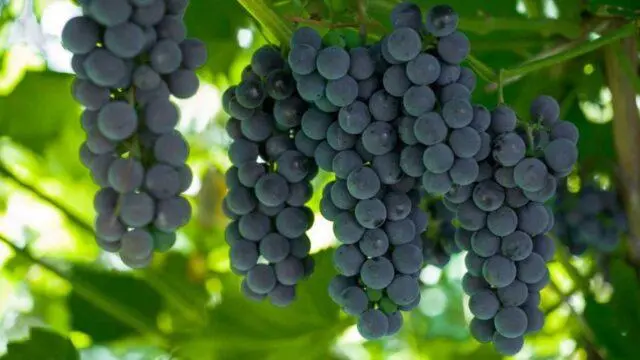
You can harvest the Alpha variety from mid-September
Muscat Hamburg (Muscat Hamburg)
One of the best technical grape varieties for winemaking is distinguished by large to medium-sized conical clusters, consisting of rounded large dark purple berries. The skin is dense, covered with abundant bloom, the flesh is juicy and fleshy.
The variety brings large yields and is characterized by high sugar content. It does not tolerate frost well, therefore it is not suitable for the northern regions.
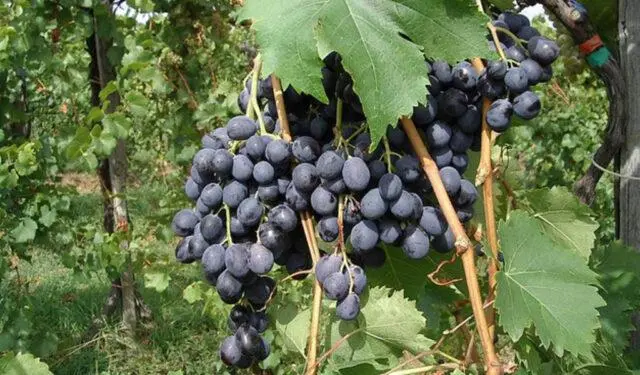
Hamburg Muscat reaches maturity by the end of September
Regent
Technical grapes of German origin belong to medium-sized varieties with slight stepson formation. It produces conical clusters of moderate density with round black berries, herbal notes are distinguishable in the taste of juicy pulp. With prolonged ripening on the bushes, it gains excess sugar content, due to which the acidity weakens, so it is not recommended to postpone the collection of fruits.
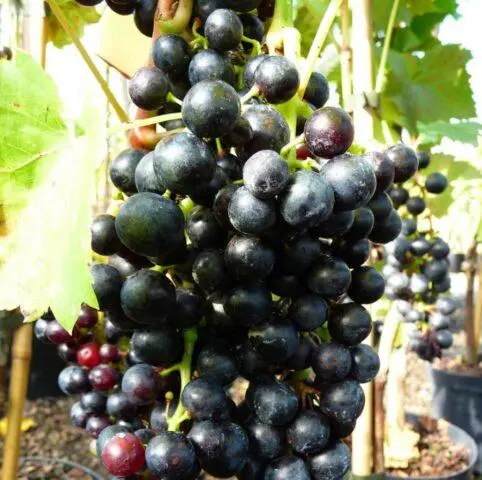
Regent grapes are harvested in the second half of September
Early technical grape varieties
On the territory of Our Country, early technical varieties are in special demand. They ripen well even in temperate climates and can be harvested in late summer or early autumn.
Delight
A technical grape variety of early ripening has good immunity to diseases and pests. Differs in high productivity and large brushes with juicy berries. The fruits are white with a yellowish tint, the sugar content of the pulp is relatively low – at the level of 15%. The variety tolerates frost well.
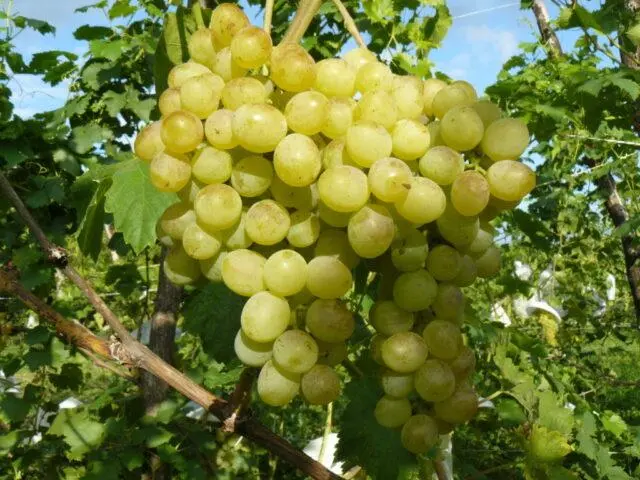
Ripening of technical grapes Rapture takes about 115 days
Фетяска (White girl)
An early Hungarian variety produces small rounded white berries with a slight golden tan and bluish bloom on the sun-facing sides. The clusters are small, up to 130 g by weight, the pulp of the fruit is harmonious in taste and combines sweetness with a slight sourness.
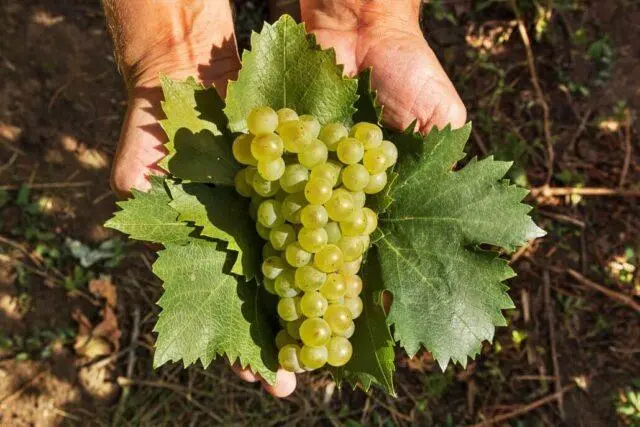
Feteaska ripens in the first half of September
Bianca
An ultra-early technical grape variety with yellow-green rounded fruits ripens in early August. Immediately after ripening, the berries are sour, but if left on the shoots, then over time they will gain sugar content. The Bianca variety is very cold-resistant, does not suffer from common fungi, but requires regular rationing of the ovaries.
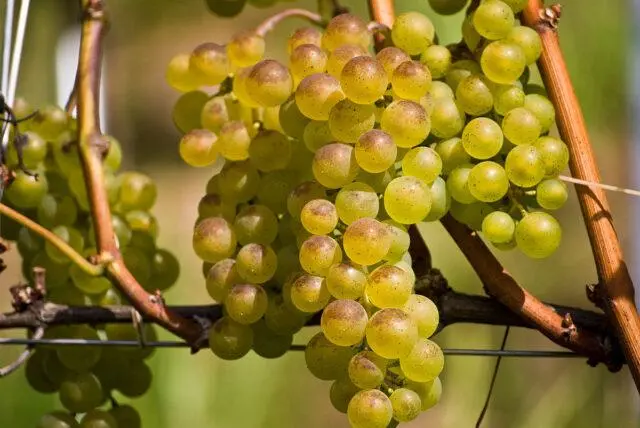
Bianca technical grapes are often damaged by wasps and birds
Technical frost-resistant grape varieties
For cultivation in the middle zone, it is necessary to consider, first of all, cold-resistant varieties. Such grapes will be able to endure frosty winters with minimal shelter and will not freeze out at temperatures below -20 ° C.
Rkatsiteli
A Georgian technical grape variety with a sugar content of up to 23% is suitable for making dessert wines and champagne. It takes root well on poor soils, is tolerant of cold and drought, bears fruit with elongated cylindrical brushes. The berries are greenish-white and can develop a beautiful purple blush when grown in full sun.
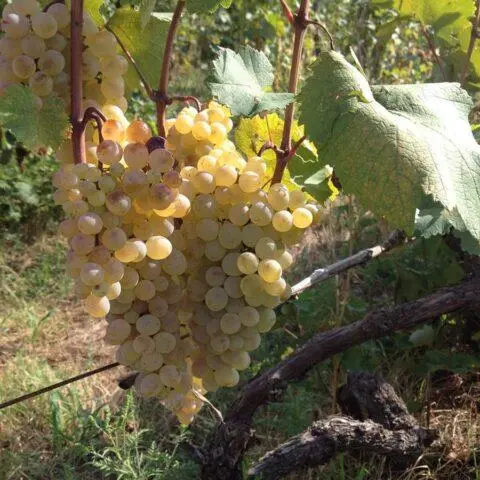
Rkatsiteli has a sweet taste with tart notes.
Amethyst
A winter-hardy technical grape variety tolerates cold snaps down to -34 ° C and can grow even in Siberia. It is distinguished by powerful vines that can withstand brushes weighing up to 800 g. The berries of the variety are juicy, dark blue in color, with a sweet taste.
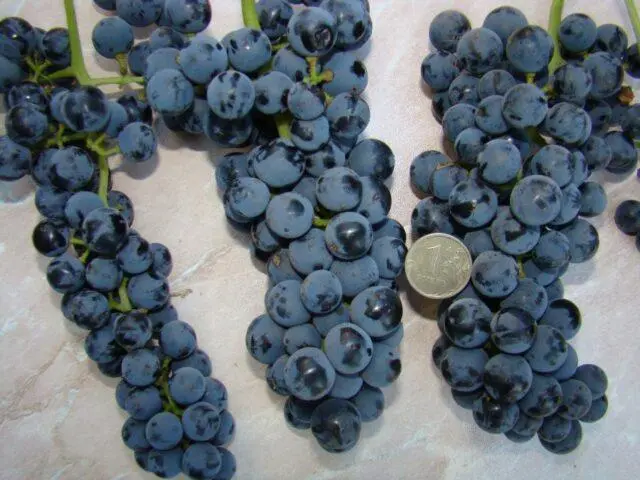
Amethyst grapes are resistant to gray rot and mildew
Valiant
A technical variety with small blue berries produces medium sized clusters. The fruits have a strawberry flavor, the sugar content is medium. The degree of frost resistance is very high – up to -45 ° C.
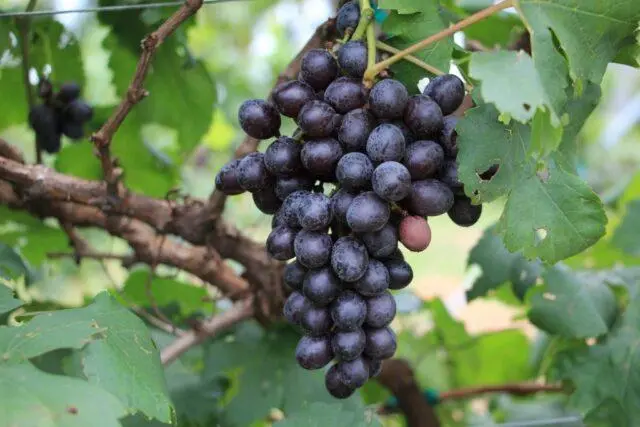
Valiant is used to make wine and jelly
New technical grape varieties
Breeders pay attention not only to table varieties, but also to technical varieties. From time to time, new varieties appear with good yields.
Agape
Technical grape variety for hot climates with white, yellowish or light pink berries produces clusters up to 300 g, conical in shape. It has a high sugar content, productive and winter-hardy, rarely suffers from fungal diseases.
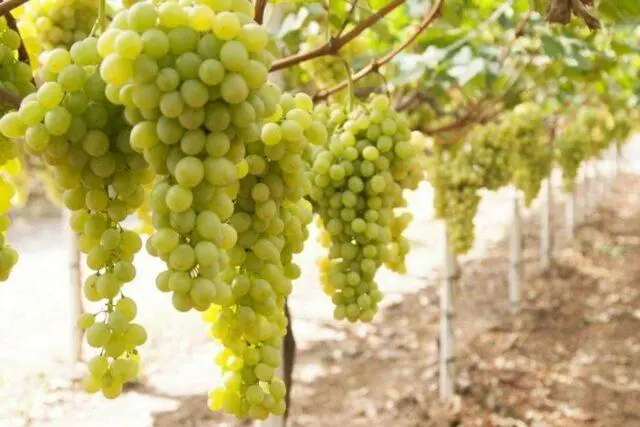
Agapi maturation takes an average of 155 days
Aretula
Greek late ripening grapes produce greenish-yellow oval berries with a thick bluish bloom. The fruits are medium in weight up to 2,5 g, with a dense, strong skin, very sweet.

Fruit-bearing vines in the Aretula variety occupy 90% of the total
Artemis (Artemis)
A young variety with shoots up to 2 m ripens in an average of 150 days. Clusters are medium, up to 200 g, berries are spherical, yellow-green, with a wax coating, up to 1,6 g by weight. The pulp is sweet and with a lot of juice. Grapes calmly react to short droughts and do not freeze in winter, but it is better to grow them in the south, where there is no shortage of heat and sun.
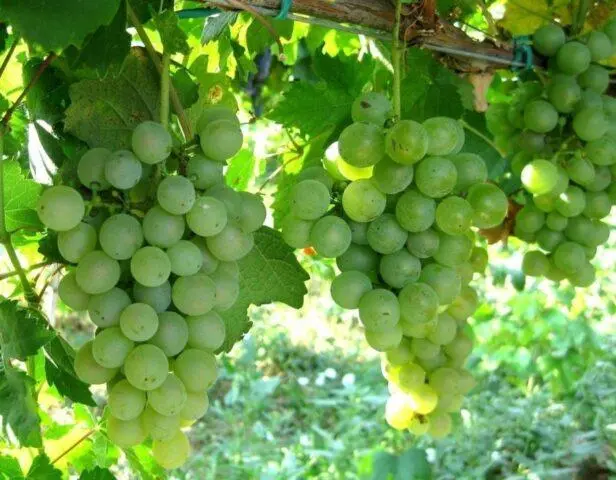
Artemis grapes are used in the manufacture of dry and sweet white wines.
Conclusion
Technical grape varieties are represented by a wide variety. According to the characteristics of the berries intended for processing, they are not inferior to table berries, but differ in small sizes and a large number of seeds.









